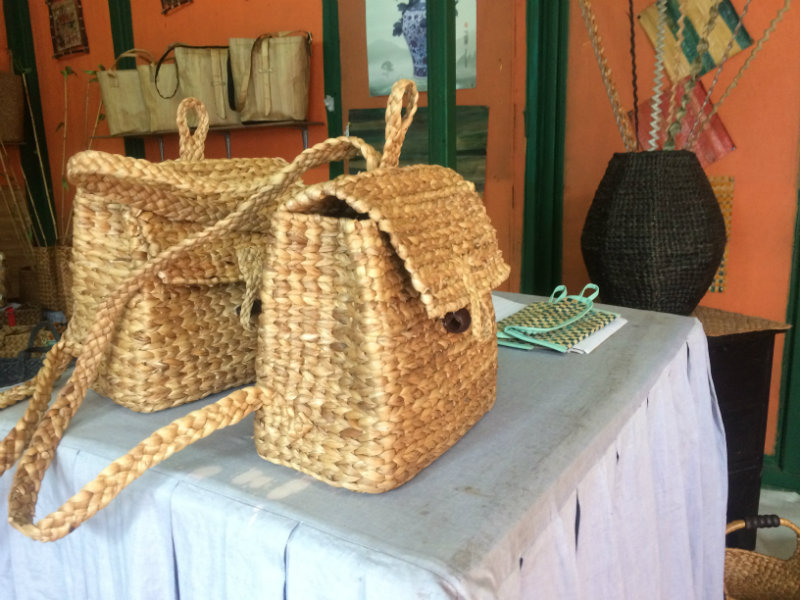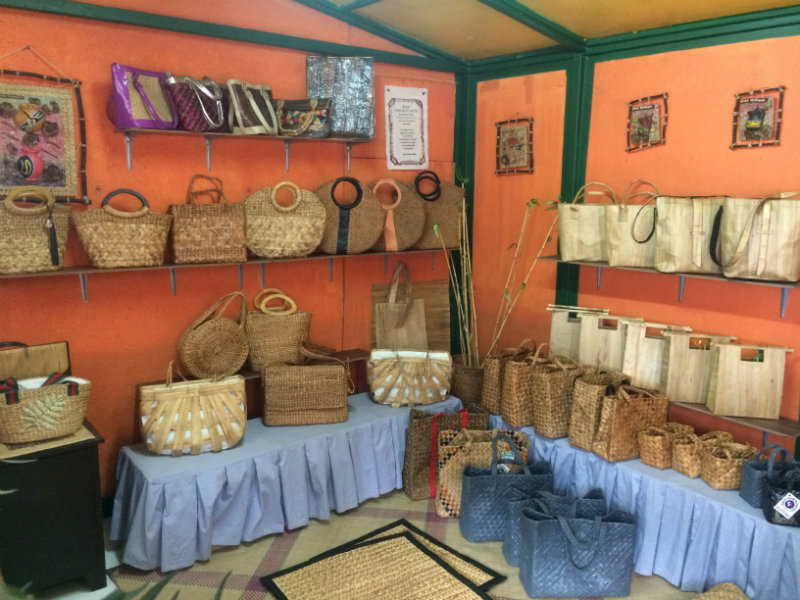Image may be NSFW.
Clik here to view.
LAGUNA, Philippines – The displacement of many families living in coastal areas around Laguna Lake during the onslaught of Typhoon Ondoy in 2009 was attributed in part to the gigantic amounts of water hyacinth (Eichornia crassipes) that have clogged waterways and caused severe flooding in Los Baños.
For this reason, it was perceived as a "public enemy" or a "pest" by residents affected by the displacement.
Fortunately, 59-year old entrepreneur Remia Adedoja found a way to turn this "pest" into something positive – source of livelihood for their community.
The proprietor of Remdavies Enterprises and the president of the Laguna Water Hyacinth Handicraft Producers Association, Inc. (LWHHPAI), Ate Remy, as she is popularly known in their community, has been enjoying the fruits of her extensive work in research and trainings with the popularity gained by handicrafts made from water hyacinth stalks.
From rattan to water hyacinth
Her success was a result of years of hard work and dedication. She recalled how she put every ounce of effort to establish and build her business from ground up.
Back in 2009, water hyacinth product manufacturing was still relatively a new concept. During that time, Adedoja was maintaining a rattan furniture business. However, the log ban forced her to find a new raw material for her handicraft business.
Image may be NSFW.
Clik here to view.
The whole thing started when she was invited to attend a seminar-training about water hyacinth production. Out of curiosoity, she joined to check if she can use it as a replacement to her rattan business.
“Nagtatatawa-tawa pa nga kami noon kasi ang lambot noong stalk o fiber ng water hyacinth. Sabi ko, hindi ito pwede sa furniture,” she said. (We were even laughing because the stalk or fiber of the water hyacinth is too soft. I told myself that this cannot be used in the furniture.)
This did not discourage her. After attending more trainings and workshops, an idea crossed her mind: What if she uses the water hyacinth fiber in making handicrafts instead of furniture?
As she ventured on this idea, her business slowly expanded.
Processing water hyacinth
Adedoja fondly recalled the first handicraft she made from water hyacinth fiber – a dusty bayong bag she made in 2009. She kept it as a reminder of how far she has reached since then.
“Una kong pinagbentahan dati eh ‘yung mga teachers kong kaibigan, worth P50 lang kasi trial ko lang naman. Sabi ko paglagyan nila ng lesson plans nila o kung ano man," she said.
(I sold my products to my friends who were teachers. I charged them P50 because they were trial products. I told them to use it to keep their lesson plans, or whatever items they have. )
From that plain bayong, her collection grew to a wide selection of beautifully crafted bags, houseware, and officeware products.
She said technology and research have greatly helped her business grow and increase its production.
With the help of the Forest Products Research and Development Institute (FPRDI) of the Department of Science and Technology (DOST), the process of manufacturing handicrafts was made a lot easier and faster. Remdavies Enterprises was granted a dryer and laminating machine that she used in drying and furnishing water hyacinth fiber, respectively.
“Dati, kapag rainy seasons, ‘yung pagpapatuyo pa lang ng fiber eh pwedeng umabot hanggang 30 days. Pero ngayon dahil sa dryer, 5 days na lang," she shared.
(During the rainy season, drying the fiber may take 30 days. With the dryer, it now only takes 5 days.)
Image may be NSFW.
Clik here to view.
Making water hyacinth handicrafts undergoes a multistage process. From harvesting water hyacinth from the Laguna Lake, the plant’s stalk is flattened, then applied with a safe chemical treatment. After that, it will be woven, colored, and adorned with finishing touches.
As a growing industry, her products have also penetrated the international market, especifically Japan. Adedoja, however, emphasized that they have higher demand in the local market with their active participation in trade fairs organized by the DOST and the Department of Trade and Industry.
Empowering women, the community
Remdavies Enterprises and the 14 other members of the LWHHPAI are social enterprises that aim to empower fellow members of their respective communities through water hyacinth prodcution.
For Adedoja and the Remdavies Enterprise, this goal translates to the employment of 60 full-time weavers working on the successive orders of bags, baskets, and trays, among many others. When the demand gets higher especially on the peak seasons of August to December, she would tap her subcontractors all over the province of Laguna.
“Isa sa pinaka-proud ako dito sa ginagawa namin ay ‘yung empowerment na naibibigay sa community at lalo na na sa mga kababaihan. Ngayon, hindi na lang ‘yung tatay ang nagtatrabaho para sa pamilya kundi pati na ‘yung nanay," she added.
(One of the things I am proud of about our project is the empowerment we provide in the community, especially among women. Now, the men are not the only ones working for their families – even the mothers are earning.)
That other than wanting to establish her own shop in a mall, she also hopes to empower more women and out-of-school youth in her community by training them in water hyacinth processing. – Rappler.com
Clyde Villanueva is a Rappler intern
Clik here to view.
Clik here to view.
Clik here to view.
Clik here to view.
Clik here to view.
Clik here to view.